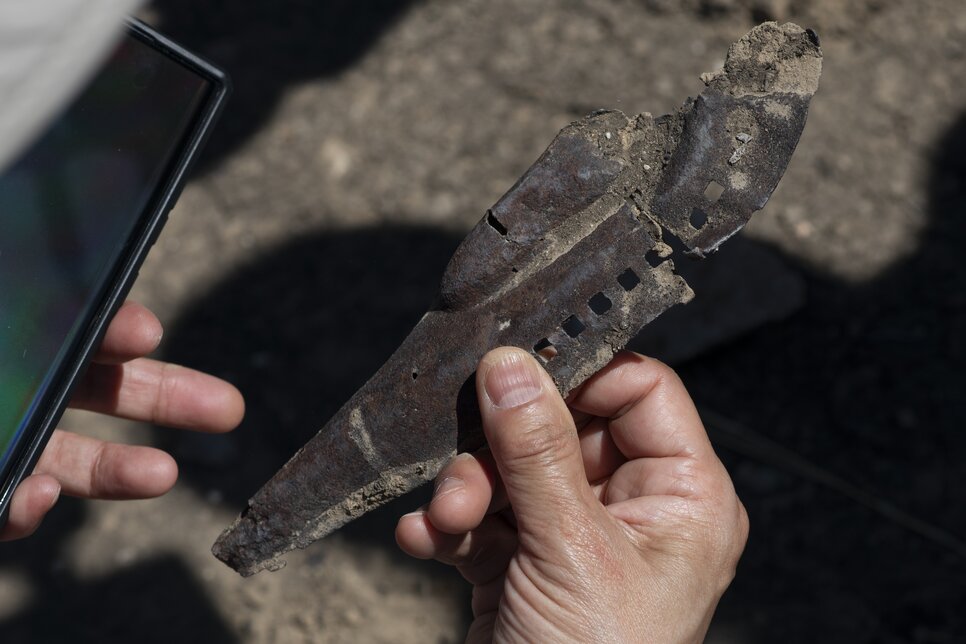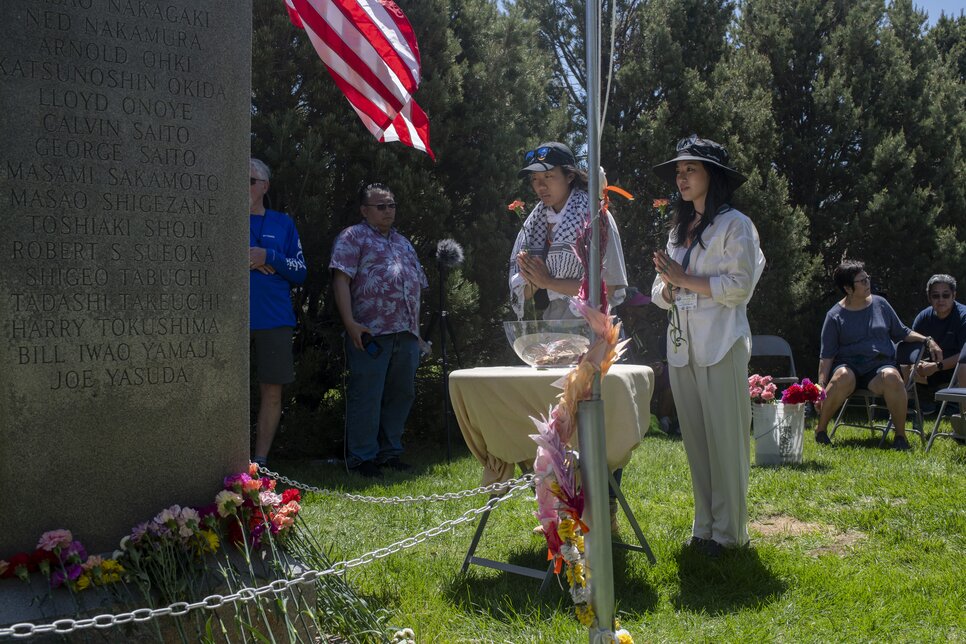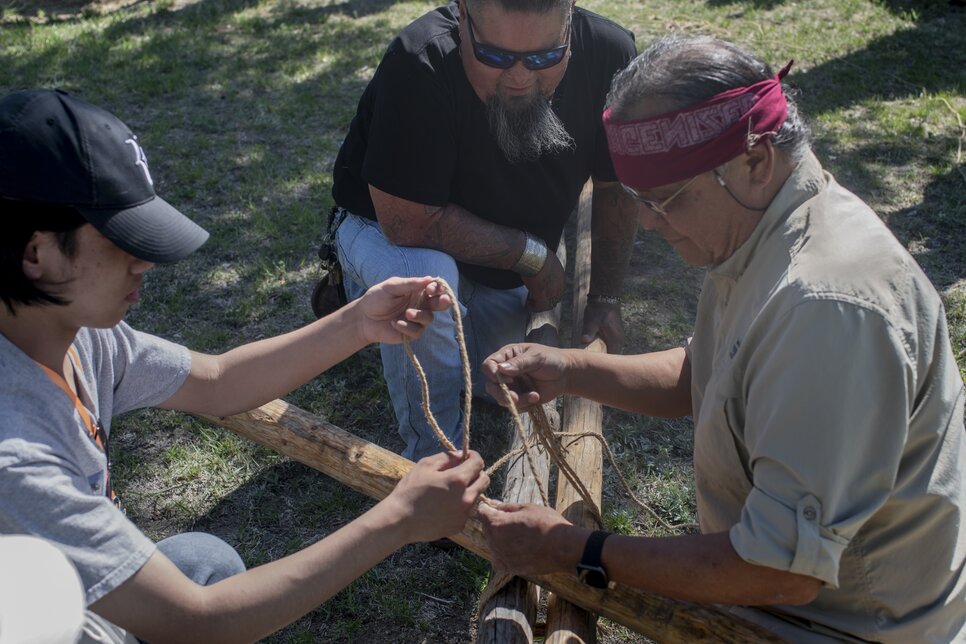Young Sand Creek and Amache descendants explore shared history
share

The Youth Ambassadors Program group walks through the grounds of Amache during tours of where family barracks and blocks sit on Saturday, May 18, 2024 at the Amache National Historic Site in Granada, Colorado.
Photo: Rachel Woolf, KUNC
Photo: Rachel Woolf, KUNC
EADS, GRANADA Colo. — In southeastern Colorado, wind is a constant presence, and the grasslands stretch as far as the eye can see. This is a remote landscape. Some might even call it sleepy. But the rural tranquility masks a grim past: Two of the darkest chapters in Colorado history unfolded on these prairies.
In 1864, two unprovoked regiments of the United States army slaughtered hundreds of peaceful Arapaho and Cheyenne people at a site near current-day Eads. The carnage later became known as the Sand Creek Massacre.
Then in the 1940s, thousands of Japanese American families were forcibly dispossessed and relocated to Amache, an internment camp just 45 miles away from Eads in Granada, where they were incarcerated for three years, until the end of World War II.

The Sand Creek Massacre National Historic Site sign on Saturday, May 18, 2024 in Eads, Colorado.
Photo: Rachel Woolf, KUNC
Photo: Rachel Woolf, KUNC
The two sites where those events took place are now both official National Historic Sites, but for the descendants of those who survived, what happened on these plains cannot simply be relegated to history. Those events disrupted their families’ paths through the world with a permanence that still resonates generations later.
On a weekend last May, a group of young descendants from both Sand Creek Massacre and Amache survivors returned to the area as "youth ambassadors." The new program, orchestrated by the Amache Alliance and the Sand Creek Massacre Foundation,seeks to help young people learn from each other and thier elders about the culture and stories that connect them indelibly to this land.
Traces of Amache
It can take special knowledge to read this land nowadays. Federal officials demolished all the buildings at Amache after the internment camp was closed in 1945, leaving only concrete foundations half-obscured in the prairie grass. But you can start to get a sense of what life was like here from the traces left behind.
On Saturday morning of the inaugural Youth Ambassador weekend, Annie Danis, a Cal Poly Pomona anthropologist who studies Amache, was at the center of a gaggle of young people crouching over one of those traces: a flattened piece of metal lying in a dirt rectangle that used to be a mess hall. Danis held up the strange object, which was oblong and folded in half with a row of holes running down the side.
“Those little parts for the wings and the windows,” she said, pointing out some of the tell-tale features to the young people surrounding her.
They correctly guessed the rusted object was an old toy airplane from the 1940s.
“So, why do you think it would be in the mess hall?” she asked.
Seventeen-year-old Kiyoshi Hasegawa took a gamble.
“Maybe children were playing in here after they finished eating while their parents were still eating,” he said.
This was Hasegawa’s second time visiting the site where ancestors were imprisoned for three years during World War II. The rising high school senior from the suburbs of Portland, Oregon, made the trip to Southeastern Colorado with his brother and parents that weekend to take part in the Youth Ambassador Program.
Finding the crumpled toy on the ground was revelatory for Hasegawa — like reaching back through time and touching a piece of his family history.

A related member of the Youth Ambassadors Program group looks at a relic found on the grounds of Amache during tours of where family barracks and blocks sit on Saturday, May 18, 2024 at the Amache National Historic Site in Granada, Colorado.
Photo: Rachel Woolf, KUNC
“Seeing that really hammers in, ‘Oh, there were, like, 2-year-olds that had to do this,’” he said. “They probably didn’t understand what was happening, or why they were here, why they were being treated like this.”
His own grandmother and her siblings were just little children when they were confined here between 1942 and 1945.
Charlene Tonai Din’s great grandparents were also imprisoned at the camp in the 1940s. But growing up, she didn't hear many stories about what happened here.
“I think partially that's because there's so much shame,” the 21-year-old said. “They're in a new country and to be singled out for something they had no control of.”
She did know their barrack number, though, and was able to step into the precise location where their tiny quarters once stood.
“Seeing the view that they saw like 80 plus years ago is something I am trying to take in right now,” she said. “I didn't realize just how powerful it could be to be physically in the same spot.”
A few feet away, 20-year-old Alliana Brady, another youth ambassador, looked on thoughtfully.
“It’s really crazy to be here,” she said. “Crazy that our government did this to its own people.”
Brady had learned a bit about America’s World War II-era Japanese internment camps in high school, but she said her education in that arena had been disappointingly shallow. She didn’t have a personal connection to this camp, like Hasegawa, Tonai Din and the other Amache descendants. Rather, she traced her lineage back to another pocket of southeastern Colorado, about 45 miles north of Amache.
“I’m a direct descendant of survivors of the Sand Creek Massacre,” she said.
But that morning at the defunct internment camp, touring the old barrack sites with the descendants of the people who were forced to live in them, gave her a firm grasp of the parallels between the Amache families and her own Cheyenne ancestors.
“Especially in the way that society treated us back then,” she said holding back tears. “Being hated for the way you looked. Not even being considered human.”
The Youth Ambassador Program was designed to spark exactly these sorts of cross-culutural insights. A Colorado Outdoor Equity Grant provided the funding to bring 12 young people ranging in age from 15 to 24 - six descendants of Amache survivors along with six descendants of the survivors of the Sand Creek Massacre - to southeast Colorado, some coming from as far away as Oregon, Oklahoma and Montana. They came to find common cause in their mutual histories of government-imposed trauma on these windswept plains.
“We also want to learn about where we come from,” Brady said. “We all still care about who we are and the sacrifice that our ancestors made to be here. We're our ancestors’ wildest dreams.”

From left, Kiyoshi Hasegawa, a member of the Youth Ambassadors Program and descendant of Amache, works on helping to put up a tipi with Greg Lamebull, and Otto Braided Hair Jr., both descendants of the Sand Creek massacre survivors, on Saturday, May 18, 2024 at the Sand Creek Massacre National Historic Site in Eads, Colorado.
Photo: Rachel Woolf, KUNC
Photo: Rachel Woolf, KUNC
A throughline in the landscape
If you ask 19-year-old Halcyon Levi, a youth ambassador and member of the Southern Cheyenne and Arapaho Tribe, the connections between the Sand Creek and Amache communities are self-evident.
“If you look at both of these communities, the reason why they faced the violence that they did was because of the federal government's involvement,” she said.
But apart from the geographic proximity and government interference, there’s also a natural affinity between these two groups that experienced firsthand the trauma of displacement in southeastern Colorado.
“My people, we originally called what is now known as Colorado our homelands,” Levi said. “Sand Creek - it severed our ties and our connections with the land, with the animals, with the plants here in this area. We were forcibly brought to Oklahoma following Sand Creek. And then, six decades later, (the Amache Families) were forcibly brought here to a rural Colorado town, and they had no say.”
Mariko Fujimoto Rooks identified a historical throughline that directly connects the atrocities at Sand Creek to the injustices at Amache. Afterall, she pointed out, Amache was built on what had once been Cheyenne and Arapaho land.
“Without the massacre and without the atrocities that happened to remove the Cheyenne from their land, you wouldn’t have this land available to put Amache on it in the first place,” said Fujimoto Rooks, an Amache descendant and one of the community leaders responsible for guiding the youth ambassadors. “The U.S. government doesn't have control over this land without massacring the people who lived there first.”
In fact, Fujimoto Rooks argued that the confinement of Japanese Americans during World War II was just another phase of the same project of displacement and colonization that swept the Cheyenne and Arapaho from the region decades earlier.
“Most of the people who were with the (War Relocation Authority), which was the department responsible for (Japanese American) incarceration, were actually from the Bureau of Indian Affairs,” she said. “So, all of their experience in forcibly moving Native Americans and then incarcerating them on reservations was used to produce the Japanese American incarceration camps.”
The youth ambassador collaboration encourages both sets of descendants to opt in to a new, cooperative relationship.
“I really feel like that's why we came together today, to talk about these traumas, to talk about our histories, but also just to be there and acknowledge each other's presence and our voices,” Halcyon Levi said. “(We’re) acknowledging that pain and that hurt and that trauma that we've carried throughout the years and how that can pass down throughout the generations.”
Fujimoto Rooks agreed.
“Our two communities have so much in common: suffering and also resilience,” she said. “Being able to build solidarity, particularly amongst this next generation of folks, feels very essential.”
History leads back to the Sand Creek Massacre
Later in the day, the 12 youth ambassadors piled into a van headed north from Amache toward the bend in Big Sandy Creek where hundreds of Arapaho and Cheyenne men, women and children were massacred by U.S. soldiers almost 160 years ago.
Greg Lamebull’s ancestors survived that day. A historian for the Cheyenne Tribe who also serves on the board of the Sand Creek Massacre Foundation, Lamebull drove out from Oklahoma for the weekend to take the youth ambassadors under his wing as a leader from the Sand Creek Massacre descendant community.
“The way we tell stories, the way we shed tears about what happened here. It’s not complete,” Lamebull said. “Right now, it’s still fresh.”
He hoped working together would allow them all some measure of closure.
“It's important that we both share the traumas that our families endured, that we had to go through,” he said. “(It’s) more or less a way to heal.”
The prairie shadows at the Sand Creek Massacre Historic Site were just starting to grow long by the time the group of youth ambassadors assembled themselves around Lamebull.
“You guys are going to help us build a tipi,” he told them. “The Cheyenne way, we use a tripod. That’s three poles put together.”
He directed their attention to a pile of pine lodgepoles on the ground.
“What I want you guys to do is pick out the longest one that’s in there,” he said. “That’s gonna be our tipi pole.”

From left, Kiyoshi Hasegawa, a member of the Youth Ambassadors Program and descendant of Amache, works on helping to put up a tipi with Greg Lamebull, and Otto Braided Hair Jr., both descendants of the Sand Creek massacre survivors, on Saturday, May 18, 2024 at the Sand Creek Massacre National Historic Site in Eads, Colorado.
Photo: Rachel Woolf, KUNC
Photo: Rachel Woolf, KUNC
Lamebull was joined by Otto Braided Hair, another Sand Creek massacre descendant and a leader in the Northern Cheyenne tribe. The two elders directed the youth ambassadors through the complicated steps of arranging the lodgepoles into a balanced pyramid, binding them with rope and wrapping them in canvas.
The process was old news to most of the group from the Sand Creek community: they had grown up raising their own tipis with their families. But the experience was entirely new for the Amache youth, who had to be schooled in the basics, like steering around the lodgepoles and canvas because stepping over them would be disrespectful.
“It’s all about respect,” Braided Hair instructed. “We're all short of that these days. We gotta have more respect.”
As the young people worked, Lamebull regaled them with stories about the long Cheyenne tradition of tipi building.
“To make one family-sized tipi, it took 36 buffalo hides,” he told them. “If you have ever worked a hide before, even a small deer, you know how hard that is.”
Charlene Tonai Din struggled with the height of the lodgepoles, as she maneuvered them into place. She said she was honored to be invited to share the experience.
“Seeing how educated these youth are about their own culture inspires me to learn more about mine,” she said. “There's so much power in doing daily acts of reclaiming that connection to our ancestors that’s lost in everyday life nowadays.”
Kiyoshi Hasegawa said he had studied the Sand Creek Massacre in history class. But raising this tipi on location with the descendants of the people who survived it gave the history vivid new meaning.
“There are some things that are just powerful and meaningful enough that they can't really be described,” he said. “It's like a feeling that you don't understand until you've done it.”
Standing in the shadows of the cottonwood trees, Alliana Brady admired their teamwork.
“It’s pretty good,” she said. “It usually takes people a little while on their first time.”
After that morning’s excursion through the foundations of the long-demolished internment camp barracks, she said it was satisfying to share with the Amache youth how her people used to occupy this land, too.
“It’s nice to show them our traditional lodges that we used to stay in,” she said. “It’s really special to me.”
At the end of the weekend, Brady and the other youth ambassadors would disperse back to their lives faraway – in keeping with that legacy of displacement. But when they returned home, they’d do so with a deeper understanding of their shared history and a connection to this newly forged community.
The group will be back in October, when the Sand Creek Massacre Spiritual Healing Run takes place. That will be another chance to deepen their bonds to each other, and to this land.
That connection to the land is important to Brady. She keeps a picture in her mind’s eye of these plains as they would have been before her people were forced to leave: a landscape teeming with tipis, just like this one.
“Sand Creek was decorated with these a long time ago,” she said. “I just imagine being surrounded by family and lodges everywhere. It just seems really beautiful.”
The photography in this story is funded by the Reflecting Colorado Photo Desk grant. KUNC, with support from the Colorado Media Project, aims to diversify visual storytelling by showcasing the rich cultural tapestry of the Centennial State. The Photo Desk project is a step towards embracing digital innovation and fostering inclusivity in storytelling.